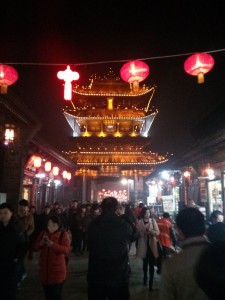Shanghai Street View: Overpowered In Pingyao

While many spent their Lunar New Year in a cutting-edge world of smartphones and virtual red envelope grabs, I had a chance to travel back to an older edition of China with a trip to interior Shanxi province. Several experiences there seemed uncomfortably close to the China from my memory in the 1980s, including a brief but chaotic ride on a local train that was packed to the gills with Spring Festival travelers.
But one particular experience seemed to summarize the many growing pains that China continues to feel in its ongoing transformation to the modern era. That experience saw the small historic banking city of Pingyao plunged into complete darkness not once, but around half a dozen times during my brief two-day sightseeing visit.
Electricity is an extremely complicated topic in China, containing all kinds of symbolism. On the one hand it literally empowers people to live more comfortable lives through the use of devices like air conditioners, floor heaters and washing machines. But at the same time, too many people still remember an era when electricity was extremely cheap and are loathe to pay more for power that used to cost them nothing.
An environmental element has entered the equation more recently, since many of China’s power plants are fueled by heavily polluting coal. The sum total is a huge mess that sees China continue to subsidize power prices for most consumers, who complain about air quality but have few qualms about using devices that strain not only the environment but also government finances and the nation’s power grid.
Some of those strains were on prominent display during my trip to Pingyao, when I arrived by train at the historic walled city and the driver who was supposed to meet me from my hotel failed to appear. I called the hotel several times, but couldn’t get through. The owner finally called me from his cellphone and apologized, saying the entire ancient city area of Pingyao had experienced a power outage making it impossible to make calls into or out of the area.
But that was just the beginning. I had just left the hotel for dinner the next day when once again the entire ancient city was plunged into darkness. The effect was quite dramatic, since Pingyao was festooned with hundreds of glowing red lanterns in shop windows and strung across the street on wires to celebrate the Lunar New Year.
The power came on again about a half hour later, but then crashed again around 9 p.m., leaving our hotel rooms in total darkness. I was foresighted enough to have a flashlight app on my smartphone, though I soon discovered it quickly sapped all the power from the battery. So it was an early bedtime for all of us in Pingyao, and I woke up the next morning to still no electricity. I soon learned that the power had come back once or twice in the night, only to break down yet again.
Any foreigner who has lived in China long enough inevitably has a selection of stories involving the struggle to keep the lights on. In the 1980s the wiring in most homes wasn’t very reliable, and the use of more than one major appliance like a refrigerator or washing machine would inevitably trip a circuit and cause all the power to shut down.
When I first moved to Shanghai in 2005, I quickly discovered the renovated home I rented in a pre-1949 building had been updated in appearance, but still contained much of its original wiring. The result was blown-out circuits whenever I used more than one major appliance at a time, and frequent trips to change a wire in a hallway box whose safety looked somewhat dubious. Even at my current home in a modern building in the Hongkou District, I recently had to struggle with power outages caused by a new air conditioner that was great at heating and cooling but too power hungry for the building wiring.
Of course I would be somewhat hypocritical if I didn’t add that I’m among the millions of people in Shanghai who enjoys paying electric rates that are well below what I’ve paid in other cities, often half or less of rates in places like Hong Kong and the US. That kind of imbalance is a major force that’s putting a big strain on the environment, government finances, and electric grids both citywide and in individual homes.
At the end of the day there probably isn’t any easy answer to the electric problem, and everyone will need to sacrifice a little to ease these and other growing pains in China’s transformation. Hopefully Pingyao and other smaller cities will learn from their experience, and find ways to end the blackout phenomenon once and for all. But in the meantime, I would highly recommend the flashlight smartphone app, which has proven quite useful on more than one occasion.
